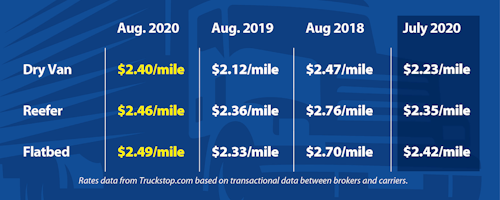In the chaotic freight market, shippers and carriers turn to short-term contracts

With 2020’s tumultuous ride on the spot market showing little signs of slowing, shippers and carriers increasingly are leaning on short-term freight contract agreements as a bridge to calmer days and a return to the usual longer-term pacts.
“Neither shippers nor carriers want to be locked in,” said Chris Caplice, an analyst for DAT Solutions and executive director of MIT’s Center for Transportation and Logistics. What he referred to as “shorter mini-bids” aren’t new, “but they’re becoming more formalized,” he said. Instead of contracts of the usual nine or 12 months, shippers and carriers are entering into three- and six-month agreements.
The reason is multifold. The mix of freight, and its geography, is dramatically different than what was anticipated at the beginning of the year. “The big word for the last few months has been ‘imbalance,’ ” Caplice said. “Some industries cratered. Some lanes disappeared. Other lanes went up by 3x. For both carriers and shippers, the network that is typically kind of balanced is now out of whack.”
That has pushed an influx of freight to the spot market, causing rates there to surge in recent months. Contract rates, meanwhile, have been more stable. With shippers, carriers and brokers all trying to manage the ongoing uncertainty and fluctuations in the market, shorter-term contracts allow parties to make agreements and be more nimble in adjusting those freight agreements as the market changes.

As this chart shows, dry van rates jumped 17 cents a mile on average from July to August. That builds on a 22-cent jump for van rates from June to July and a 17-cent jump from May to June. Reefer and flatbed rates saw similar climbs. Reefer rates are up on average 34 cents a mile since April and flatbed rates are up 28 cents a mile since April.
Overall, total net freight volumes are roughly on par with last year, though it’s hard to pin down exactly, said Ken Adamo, chief of analytics for DAT. “Industrials are lagging so hard,” he said. “That’s such a big part of the domestic freight economy, it’s hard to outrun that.”
But while industrials – such as inbound and outbound manufacturing loads – have stumbled, other freight sectors have picked up. Think March and April’s surge to restock grocers and, since then, the retail boom in areas such as furniture, appliances, home goods, exercise equipment and residential construction. “There have been some weird silver linings with the pandemic and how people have reacted,” said Caplice, referring to those targeted spikes in consumer spending.
Goods producers and many food makers have had to find new suppliers to keep up with the unexpected surge in demand. What that means, said Caplice, “isn’t just new suppliers, but all-new lanes” for freight to get where it’s needed. Those new suppliers and new lanes are another contributor to the jolt in the supply chain.
Some shippers have reported being at peak annual volumes for 16 straight weeks, said Adamo. A household-name food provider told Adamo that the restocking surge in the spring “felt like the grand opening of a grocery store every day” for about a month.
For shippers, “there’s no volume discount,” said Caplice. In fact, it’s the opposite, he said. “The 10th truck is more expensive than the eighth truck,” he said, referring to shippers buying capacity from carriers.
Despite the entire market being turned upside down, and with a freight crash followed by a freight boom within a six-month span, “markets are functioning,” said Adamo. “We’re not hearing widespread reports of loads not moving due to capacity issues. Higher rates are bringing more capacity into the spot market. Everything is functioning as it should.”
That’s an important point with the holiday freight season just around the corner. Though some items might become harder to find than others, the hurdles this year have in some ways prepped the supply chain for the peak retail season. “E-commerce has been dealing with Christmas-level volumes for the last five months,” said Caplice. “The stuff we want for Christmas is already here,” he said, referring to domestic inventories. “It’s just not where it needs to be.”
Likewise, said Adamo, if Congress passes another round of economic stimulus or restores the unemployment benefits that ended last month, and with consumer spending already brimming, “it could make for a wild retail season,” he said
